NCERT Based Activity: The Invisible Living World: Beyond Our Naked Eye | Science Curiosity Class 8 - New NCERT PDF Download
Activity 2.1: Let us observe
Take a round-bottom flask made up of glass as shown in Fig. 2.1. Fill it with water.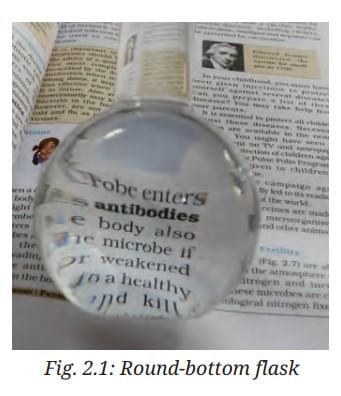
Close the mouth of the flask with a cork.
Now, place the flask on an open book and look at the letters through it.
1. Do you notice something interesting?
Ans: Yes, the letters appear larger when seen through the flask.
2. Why does this happen?
Ans: This happens because the flask filled with water acts like a magnifying glass.
Now, use a real magnifying glass to look at small organisms, like an ant.
3. Were you able to see the details of its body more clearly?
Ans: Yes, the details of the ant's body are seen more clearly with the magnifying glass.
Activity 2.2: Let us study a cell (Teacher demonstration activity)
- Take an onion bulb from your kitchen or garden and wash it thoroughly with water.
- Cut the onion bulb vertically into pieces.
- Take one piece of onion and pull out the thin, transparent layer from its inner surface with the help of forceps. This layer is called the onion peel.
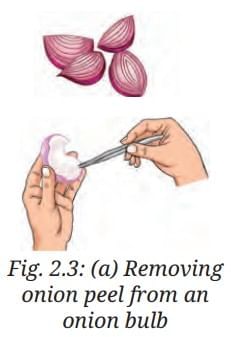
- Place the peel in a petri dish containing a few drops of safranin (red-coloured stain) for 30 seconds. This will give a pinkish colour to the cells and help us see them clearly.
- With the help of thin brush transfer the onion peel to another petri dish containing water to rinse the peel and remove extra stain.
- Now, carefully place the stained onion peel on the glass slide using a thin brush, ensuring it does not break or fold.
- Put a drop of glycerin over the onion peel on the slide. The glycerin will prevent drying of the cells and improve clarity for better visualisation of cells.
- Slowly place a coverslip over the peel using a needle, such that no air bubbles get trapped.
- Use blotting paper to gently wipe off any extra glycerin around the edges of the coverslip.
- View the slide under a microscope or a foldscope. Compare it with Fig. 2.3c.
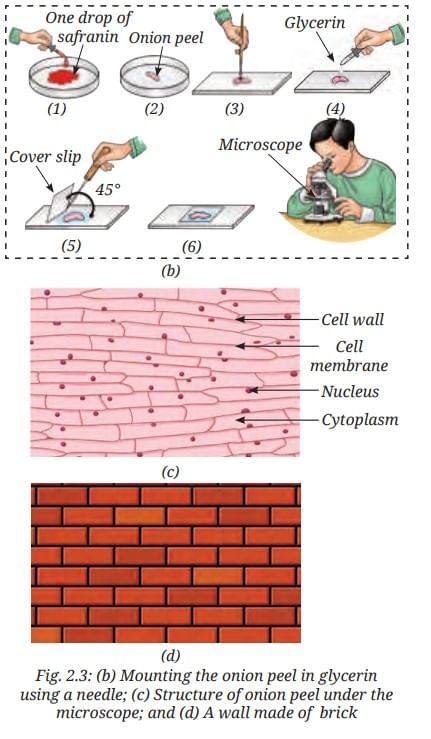
1. What similarities do you find in Fig. 2.3c and Fig. 2.3d?
Ans: Both show rectangular structures arranged closely without spaces, like bricks in a wall.
Observation: You will observe nearly rectangular structures under the microscope. These are the cells of the onion peel, which are closely arranged without any space between them.
Try to observe the peels of the leaves of different plants around you.
2. You will find that all plants are made up of cells. What do you think the body of an animal is made of?
Ans: The body of an animal is also made up of cells.
Activity 2.3: Let us investigate
- Rinse your mouth with clean water.
- Use the blunt end of a clean toothpick, and gently scrape the inside of your cheek.
- Place the scraped material in a drop of water on a clean glass slide and spread it evenly.
- Add a drop of methylene blue (a blue-coloured stain) over the material on slide. Adding stain improves the visibility of the material under the microscope by increasing contrast.
- After one minute, add a drop of glycerin over the material on the slide to prevent the cells from drying.
- Now, carefully place a clean coverslip on the material, and remove the excess glycerin from the edges of the coverslip using blotting paper.
Observe the slide under a microscope and draw what you see in your notebook.
1. What did you observe?
Ans: You will observe a polygon-shaped structure as shown in Fig. 2.4. These are cheek cells, which form the inner lining of your mouth.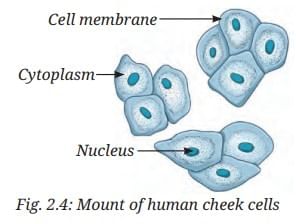 2. What similarities and differences did you observe between the cells of onion peel in Activity 2.2 and human cheek cells in Activity 2.3?
2. What similarities and differences did you observe between the cells of onion peel in Activity 2.2 and human cheek cells in Activity 2.3?
Ans:
- Similarities: Both have cell membrane, cytoplasm, and nucleus.
- Differences: Onion cells are rectangular with cell walls; cheek cells are polygonal without cell walls.
Activity 2.4: Let us observe pond water/stagnant water
- Take a container and collect pond or stagnant water in it with the help of your teacher or elder(s).
- Use a dropper and place a drop of pond or stagnant water on a microscope or foldscope slide. Put a coverslip and observe it under the microscope or foldscope.
- Observe the tiny organisms found in the pond or stagnant water.
Observation: You may observe small moving organisms like protozoa (Amoeba, Paramecium), algae, or other microbes as in Table 2.1.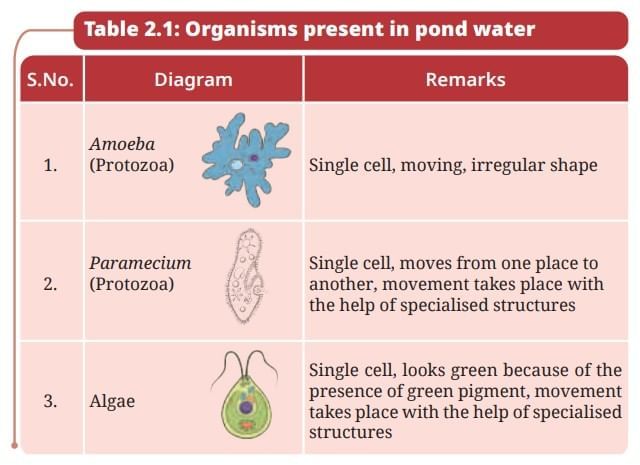
Activity 2.5: Let us observe soil suspension
- Take a beaker and collect some moist soil in it from the nearby field or garden. Do not touch the soil with your bare hands — use a spoon or gloves.
- Pour some water into the beaker and stir it with a glass rod. The liquid, which may look dirty, has very fine particles of soil, and is called soil suspension. Keep it aside for some time and let the mixture settle.
- Use a dropper and take a drop of water from the top layer. Place the drop on a microscope slide.
- Cover it gently with a coverslip and observe it under the microscope (Fig. 2.8).
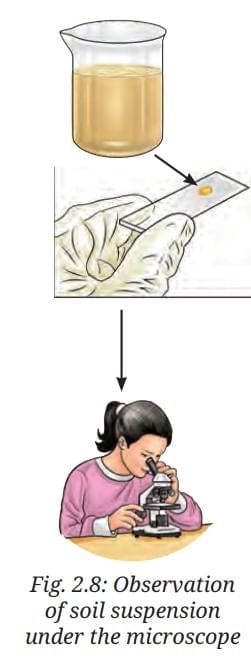
Observation: You may observe small moving organisms similar to those you saw in Activity 2.4. This indicates that even soil suspension contains a variety of tiny creatures that cannot be seen with the unaided eye.
Activity 2.6: Let us study
A group of students studying in Grade 8 performed Activities 2.4 and 2.5. They also collected information from the library and internet. They recorded the data obtained after observing pond water in Table 2.1 and the data obtained after observing soil suspension in Table 2.2. They identified the microorganisms as protozoa, algae, fungi, and bacteria. You can record if you find any of these categories of organisms.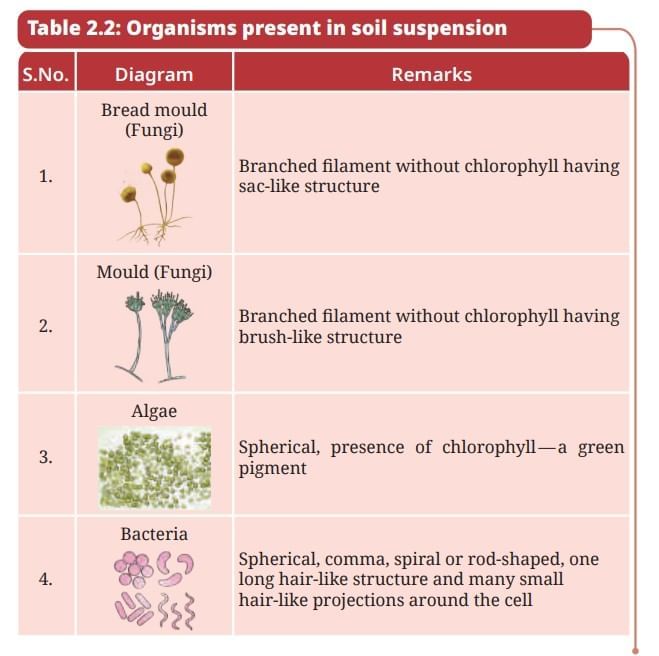
1. Did you also observe any of these microorganisms or something different? Record in your notebook and discuss in your class.
Ans: Observations may vary, but common ones include Amoeba (protozoa: single cell, moving, irregular shape), Paramecium (protozoa: single cell, moves with specialized structures), Algae (single cell, green due to chlorophyll), Bread mould (fungi: branched filament with sac-like structure), Mould (fungi: branched filament with brush-like structure), Bacteria (spherical, comma, spiral or rod-shaped with hair-like structures).
Activity 2.7: Let us do
- Take an empty container and fill it halfway with garden soil.
- Add some fruit and vegetable peels to the container. Thereafter, put a layer of soil on it and leave it aside.
- After 2–3 weeks, observe the changes that have taken place.
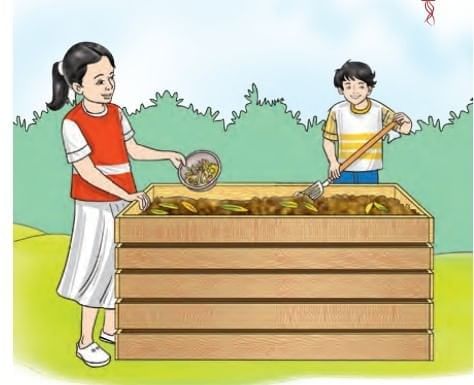 Recycling of nutrients by making manure
Recycling of nutrients by making manure
1. Do you observe any difference in the contents of the container?
Ans: Yes, the peels of fruits and vegetables have turned into a dark-coloured material.
2. But how did the peels of fruits and vegetables turn into manure?
Ans: Microorganisms like fungi and bacteria in the soil act on the plant waste and slowly break it down into simpler, nutrient-rich manure.
Activity 2.8: Let us perform
- Take two bowls A and B.
- In each, take 200 g of flour (atta or maida) and add a pinch of sugar.
- Now, in bowl A, add a small amount of yeast powder and mix it well with the flour.
- In bowl B, do not add any yeast, so that we can compare the results of the two bowls.
- Knead the flour of the two bowls with warm water to make soft dough (Fig. 2.11).
- Cover the dough with a damp cloth and keep it in a warm place.
- Observe both the bowls after 4–5 hours.
1. Did you find any change in the volume, smell, or texture of the dough? If not, leave the dough for some more time.
Ans: After some time, the dough in bowl A (with yeast) has risen slightly, become fluffy, and has a different smell compared to the dough in bowl B (without yeast).
2. Why does this happen? What is the role of yeast? Why did we add sugar and warm water to the flour?
Ans: Yeast (a fungus) respires, breaking down sugar to release carbon dioxide (making dough fluffy) and alcohol (different smell). It grows well in warm conditions with sugar as food.
Activity 2.9: Let us prepare
- Take two small glass bowls — label them ‘A’ and ‘B’.
- Pour lukewarm milk in bowl A, and cold milk in bowl B.
- Now, add a small spoonful of curd to each bowl and mix well using a spoon.
- Cover both bowls. Keep bowl A in a warm place and bowl B in a cool place (like a refrigerator) for a few hours or overnight.
- Observe the changes in the glass bowls. Write your predictions and observations in Table 2.4.
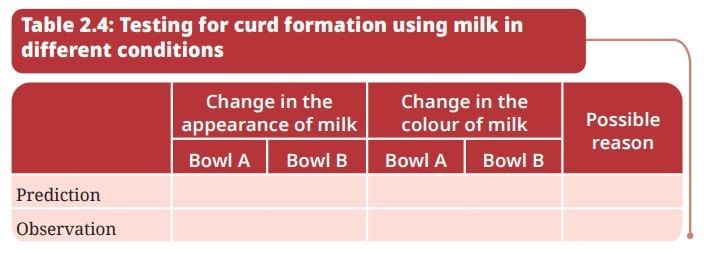
Predictions and Observations:
- Change in appearance: Bowl A: Milk turns into curd (thickens). Bowl B: No change or slight souring.
- Change in colour: Bowl A: No major change, but sour. Bowl B: No change.
- Possible reason: Bowl A: Bacteria (Lactobacillus) multiply in warmth, fermenting lactose to lactic acid. Bowl B: Cold inhibits bacterial growth.
|
59 videos|347 docs|13 tests
|
FAQs on NCERT Based Activity: The Invisible Living World: Beyond Our Naked Eye - Science Curiosity Class 8 - New NCERT
| 1. What are microorganisms and why are they important in our ecosystem? |  |
| 2. How can we observe microorganisms in pond water? |  |
| 3. What is the significance of studying soil suspension in understanding the living world? |  |
| 4. Why are some microorganisms harmful while others are beneficial? |  |
| 5. How do scientists use experiments to study microorganisms? |  |
















